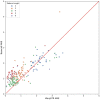WarpSTR: determining tandem repeat lengths using raw nanopore signals
- PMID: 37326967
- PMCID: PMC10307940
- DOI: 10.1093/bioinformatics/btad388
WarpSTR: determining tandem repeat lengths using raw nanopore signals
Abstract
Motivation: Short tandem repeats (STRs) are regions of a genome containing many consecutive copies of the same short motif, possibly with small variations. Analysis of STRs has many clinical uses but is limited by technology mainly due to STRs surpassing the used read length. Nanopore sequencing, as one of long-read sequencing technologies, produces very long reads, thus offering more possibilities to study and analyze STRs. Basecalling of nanopore reads is however particularly unreliable in repeating regions, and therefore direct analysis from raw nanopore data is required.
Results: Here, we present WarpSTR, a novel method for characterizing both simple and complex tandem repeats directly from raw nanopore signals using a finite-state automaton and a search algorithm analogous to dynamic time warping. By applying this approach to determine the lengths of 241 STRs, we demonstrate that our approach decreases the mean absolute error of the STR length estimate compared to basecalling and STRique.
Availability and implementation: WarpSTR is freely available at https://github.com/fmfi-compbio/warpstr.
© The Author(s) 2023. Published by Oxford University Press.
Conflict of interest statement
None declared.
Figures







References
-
- Andrew SE, Goldberg YP, Theilmann J. et al. A CCG repeat polymorphism adjacent to the CAG repeat in the Huntington disease gene: implications for diagnostic accuracy and predictive testing. Hum Mol Genet 1994;3:65–7. - PubMed
-
- Bellman R, Kalaba R.. On adaptive control processes. IRE Trans Automat Contr 1959;4:1–9.
-
- Budiš J, Kucharík M, Ďuriš F. et al. Dante: genotyping of known complex and expanded short tandem repeats. Bioinformatics 2019;35:1310–7. - PubMed
Publication types
MeSH terms
LinkOut - more resources
Full Text Sources
Molecular Biology Databases

